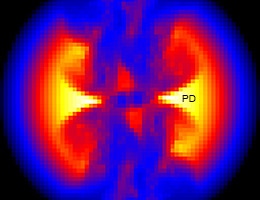May 21 2019
Astronomers have found out what is called a proto-disk surrounding Mayrit, a proto-brown dwarf. This discovery allowed them to confirm, for the first time, that this celestial body was formed quite similar to sun-like stars.
 The CC model predicted integrated intensity map in the CO (2-) line derived from the best fit to the observed CO line. The peak CO emission, as predicted by the model, arises from the outer edges of the pseudo-disk (labeled “PD”). (Image credit: Riaz et al., Fig. 20, MNRAS 2019)
The CC model predicted integrated intensity map in the CO (2-) line derived from the best fit to the observed CO line. The peak CO emission, as predicted by the model, arises from the outer edges of the pseudo-disk (labeled “PD”). (Image credit: Riaz et al., Fig. 20, MNRAS 2019)
The characteristics of brown dwarfs lie between those of planets and stars. They have a mass that is too small to preserve the hydrogen fusion process, which is a process characteristic to a star. At the same time, they are considerably more massive compared to huge planets—they have a mass about 10 times that of Jupiter or more.
This mass is adequate enough to initiate a deuterium fusion in the core. This is precisely why they can shine like faint stars when they are young. Despite the fact that brown dwarves occur commonly in the universe, it is challenging to analyze and investigate them. Specifically, their formation is a disputable topic.
For the first time, Basmah Riaz, an LMU astronomer, has verified what is called a pseudo-disk surrounding a proto-brown dwarf, in collaboration with Masahiro Machida (Kyushu University, Japan) and Dimitris Stamatellos (University of Central Lancashire, Great Britain). This is further evidence for the fact that brown dwarves appear based on the same rules as “true” stars. The researchers have described their study outcomes in the trade journal Monthly Notices of the Royal Astronomical Society.
A decade ago, a model was already developed in which brown dwarves are formed, like normal stars, through the collapse of a cloud of gas and dust. However, so far there had been no observation data that confirm this.
Basmah Riaz, Astronomer, LMU Munich
According to the predictions of the model, a pseudo-disk of a specific mass, size, and shape must appear surrounding the brown dwarf. The formation of the star typically occurs in three successive phases.
Firstly, the proto-star is deeply ingrained in a thick cloud of dust and gas. Subsequently, this cloud starts dispersing and gradually forms a disk-like structure—the pseudo-disk. Ultimately, only a disk is left behind and there is no more cloud. Riaz and colleagues used the data from the Atacama Large Millimeter/Submillimeter Arrays (ALMA)—an international radio telescope observatory located in the Chilean Andes—and have been successful in proving for the first time that there is indeed such a pseudo-disk surrounding the proto-brown dwarf Mayrit 1701117.
It is particularly exciting that we received both the signals of the collapsing gas cloud as well as the forming pseudo-disc. Thus our data confirm the model and show that brown dwarves go through the same stages of development as stars similar to the sun.
Basmah Riaz, Astronomer, LMU Munich
Moreover, the researchers could not just prove the presence of the pseudo-disk, they could also determine its age: it was most probably formed 30,000 to 40,000 years ago—in cosmic terms, the origin of Mayrit 1701117 is still at a very early stage.